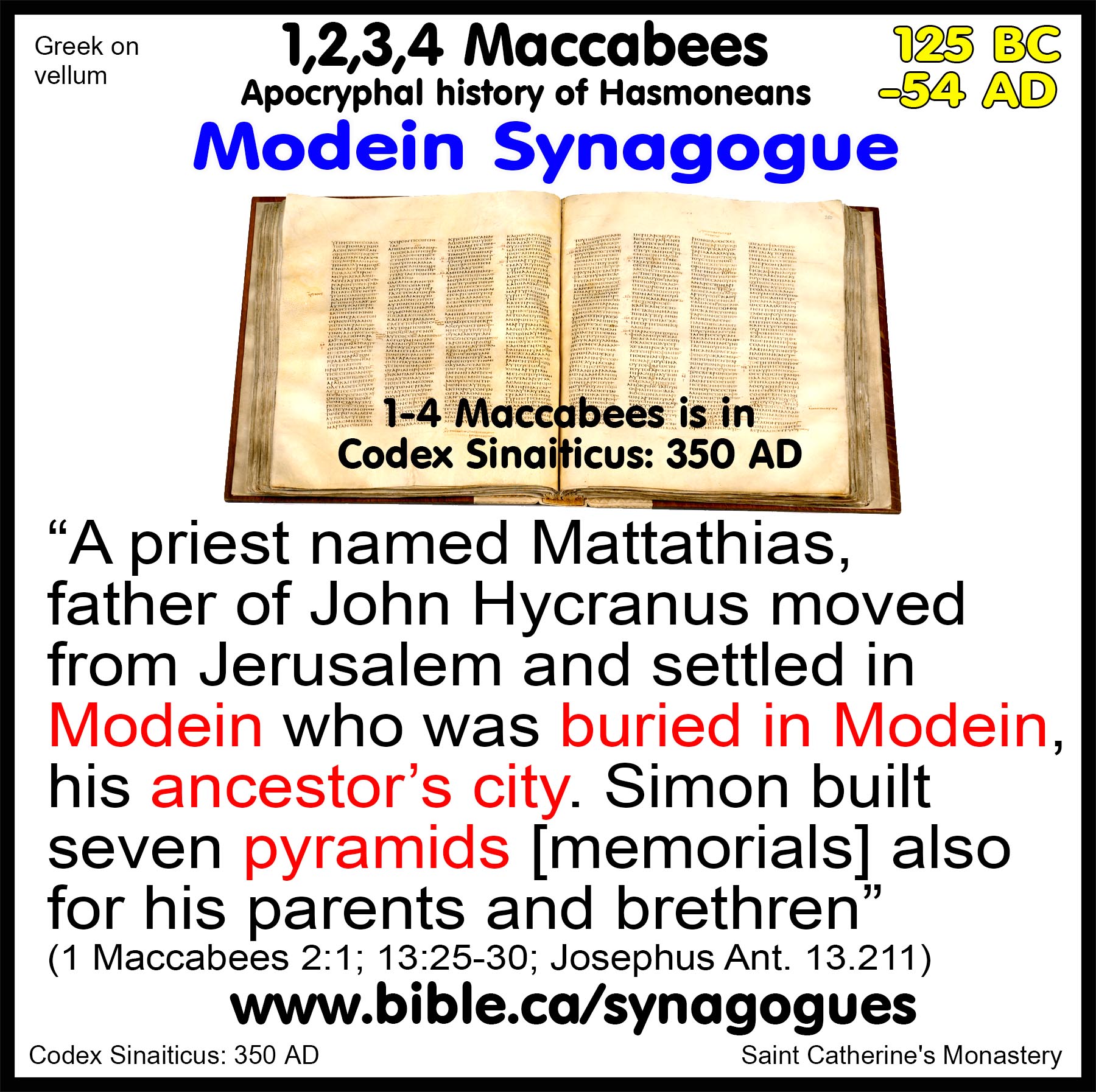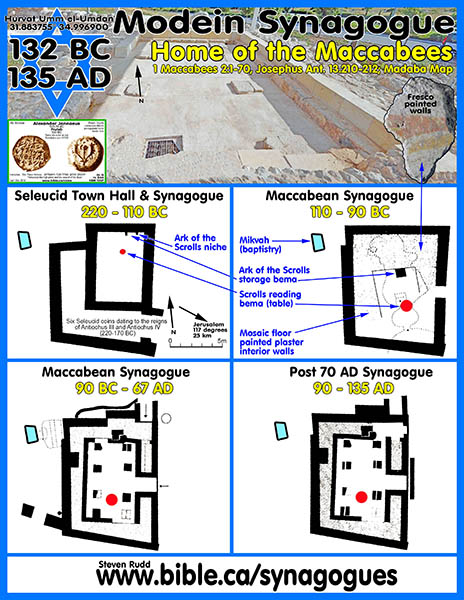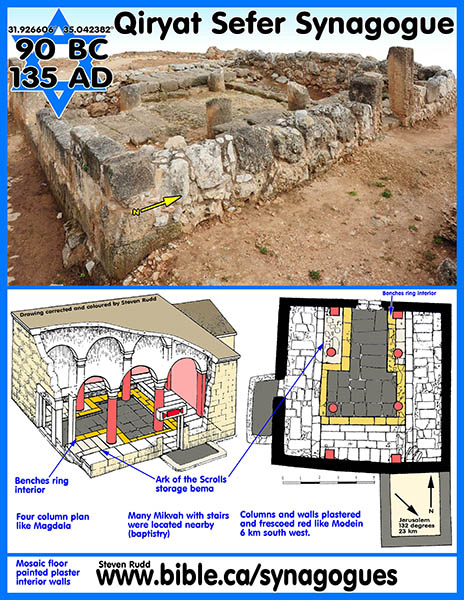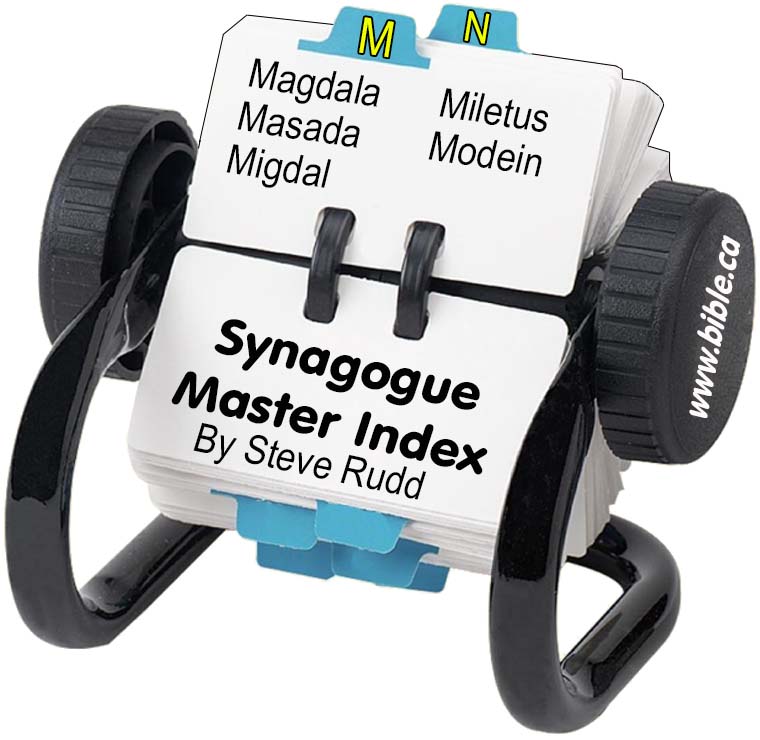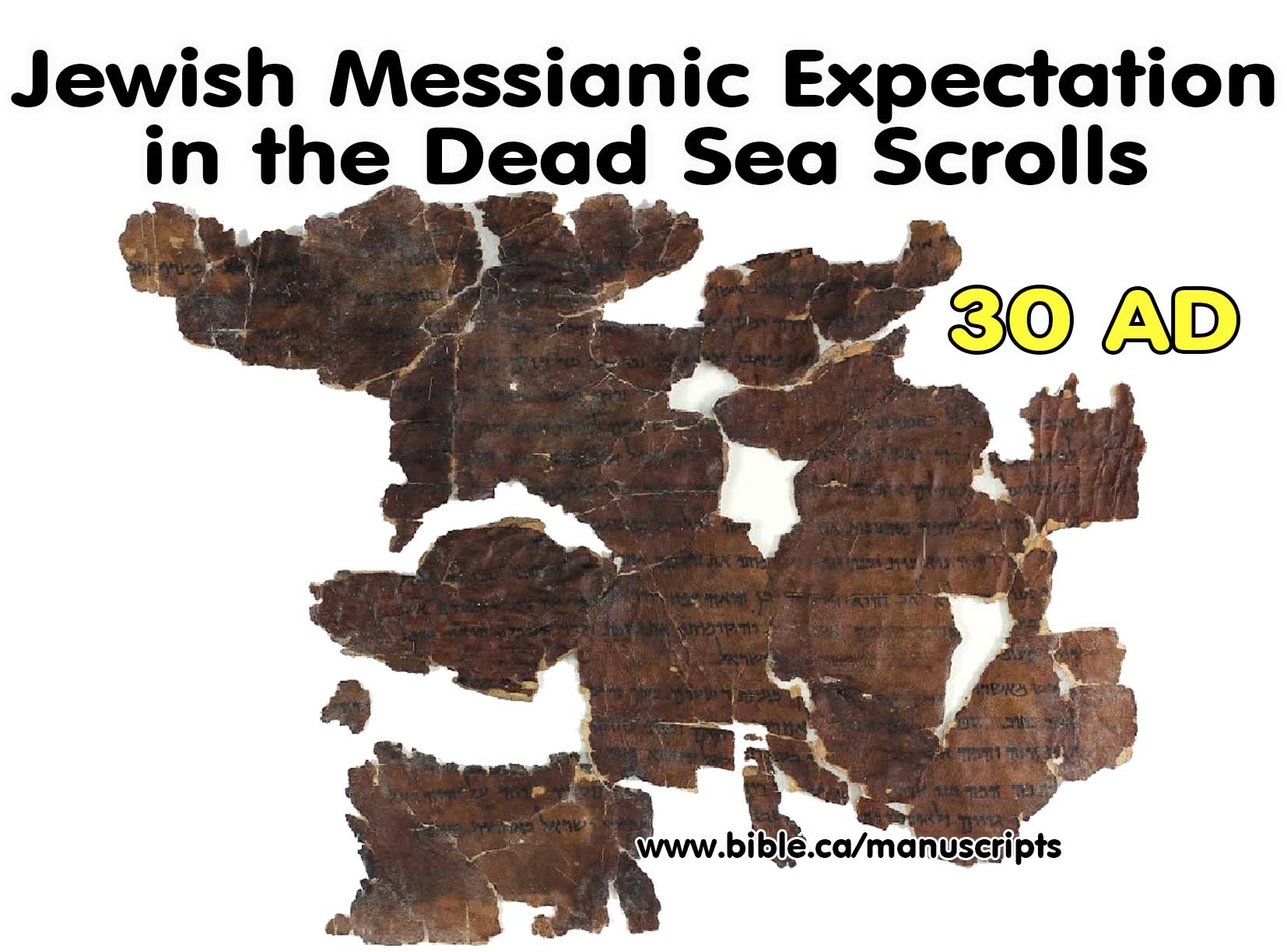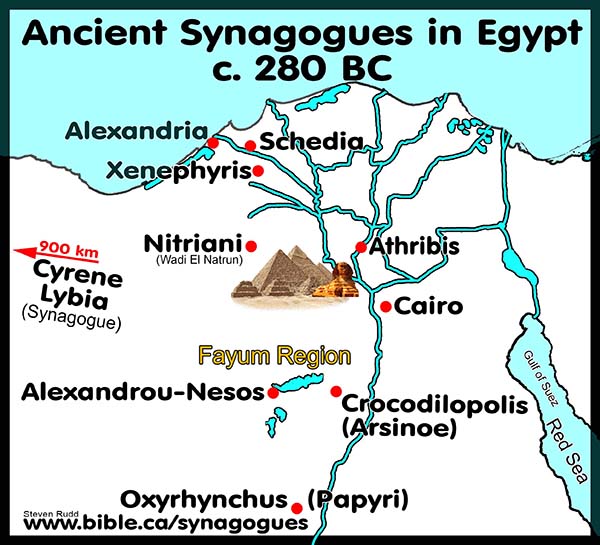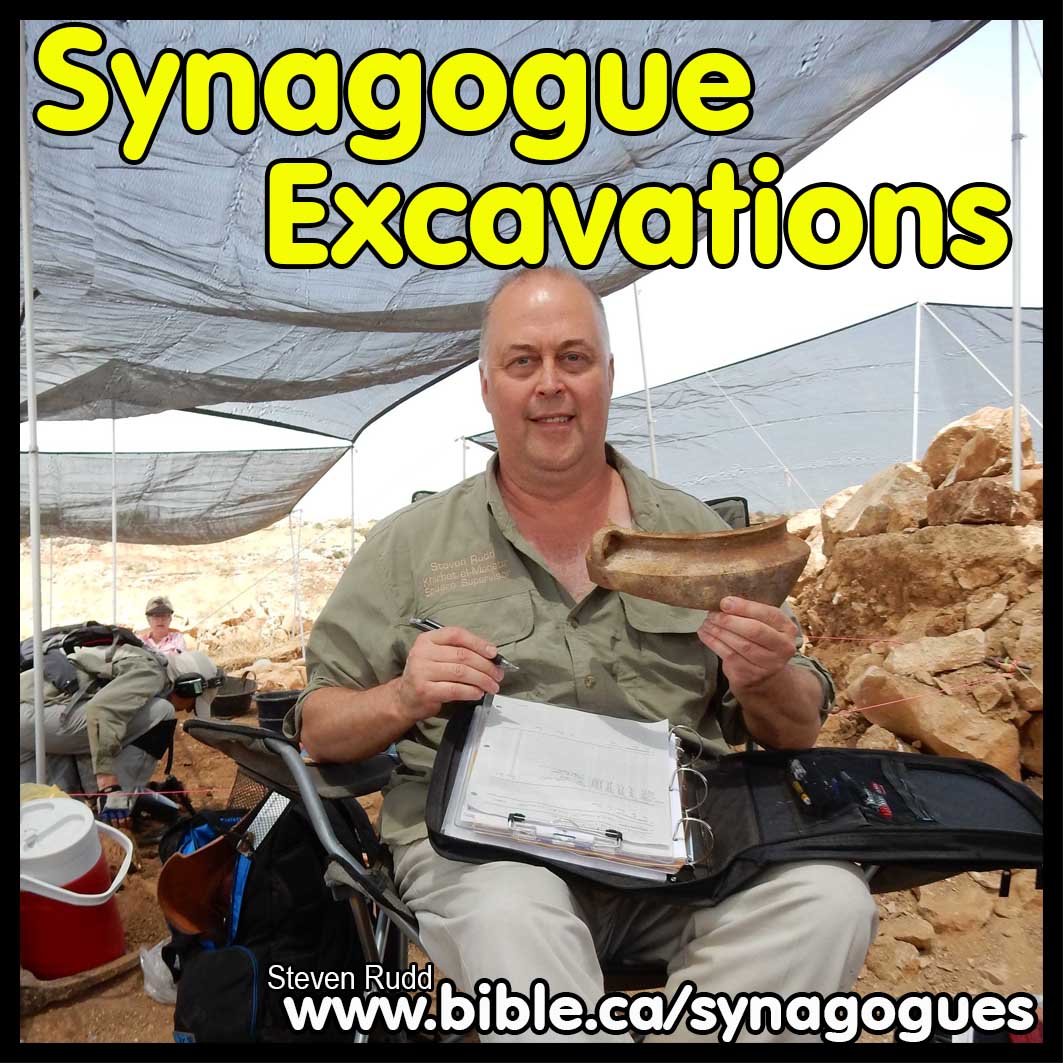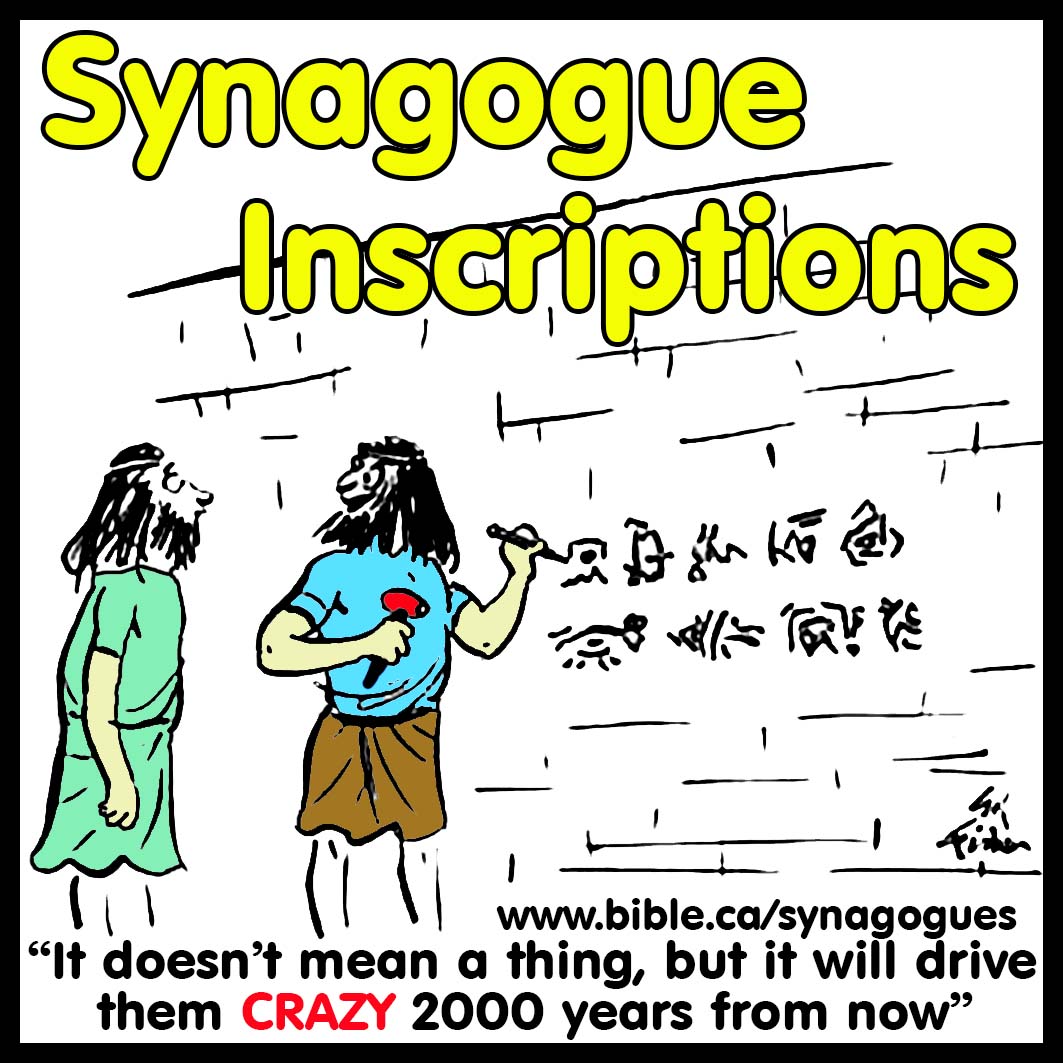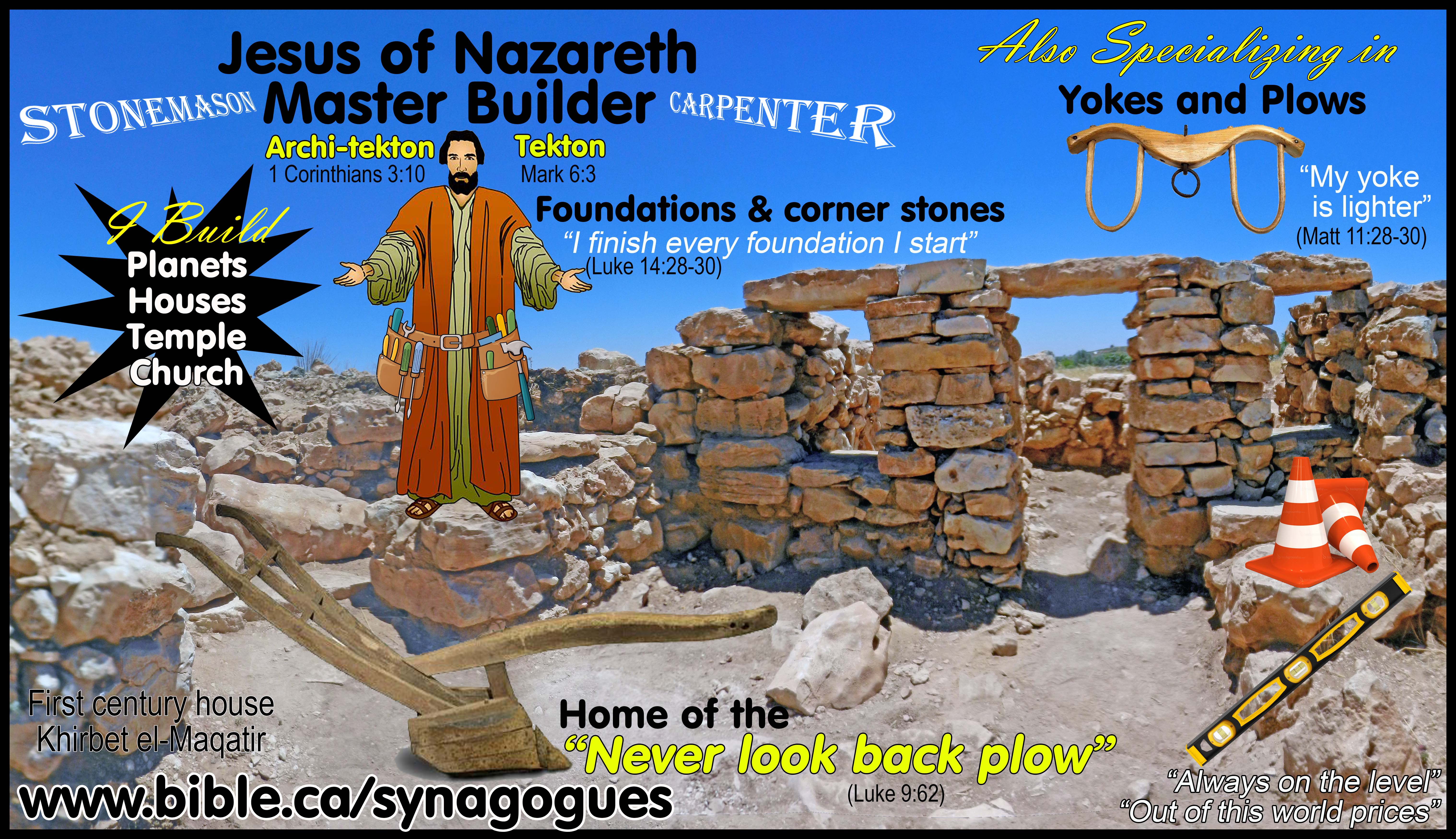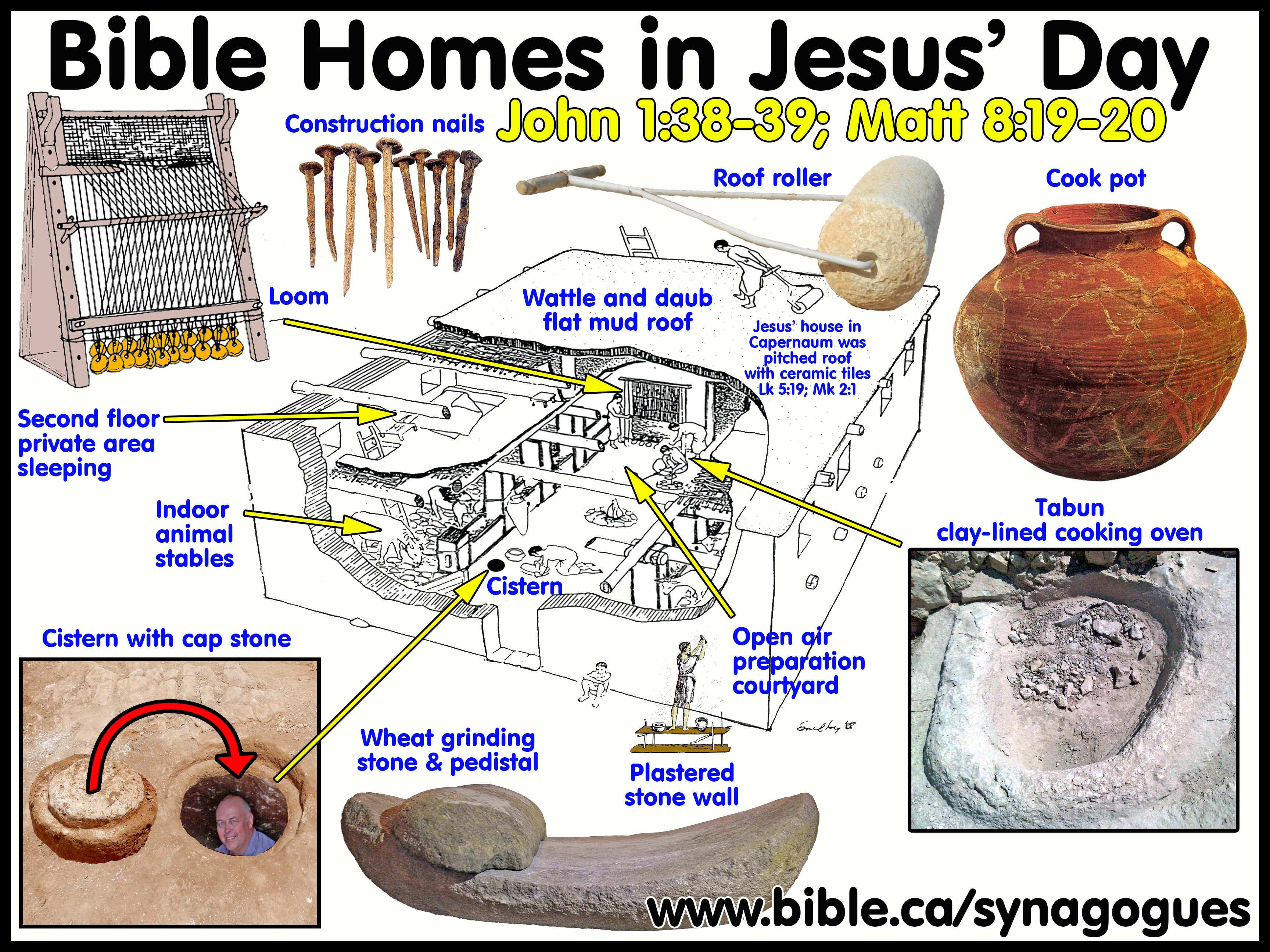1st 2nd 3rd 4th Maccabees
1st Maccabees: 125 BC
2nd Maccabees: 125 BC
3rd Maccabees: 75 BC
4th Maccabees: 19-54 AD
Ancient Synagogue Literary Sources
All four apocryphal books of Maccabees were contained in Codex Sinaiticus: 350 AD
125 BC - 54 AD
“A priest named Mattathias, father of John Hycranus moved from Jerusalem and settled in Modein who was buried in Modein, his ancestor’s city. Simon built seven pyramids [memorials] also for his parents and brethren” (1 Maccabees 2:1; 13:25-30; Josephus Ant. 13.211)
A. Dates of writing the 1,2,3,4 Maccabees: All four apocryphal books of Maccabees were contained in Codex Sinaiticus: 350 AD
1. Date of 1st Maccabees: 125 AD “In the text itself there is no indication of who wrote the book; however, it is evident that the author was a devotee of the Hasmonean dynasty who justifies and extols the exploits of the Maccabean brothers. Since the book ends at the beginning of John Hyrcanus’s reign, it is likely to have been completed sometime during that ruler’s reign, perhaps about 125 b.c. (some scholars would date it to the beginning of Alexander Janneus’s reign, or about 100 b.c.). (Dictionary of New Testament Background, First Maccabees, p657, 2000 AD)
a. “First Maccabees is a history of the rise of the Hasmonaean dynasty, from the daring deeds of the zealous priest Mattathias to the reign of John Hyrcanus, high priest and prince of the Jews by dynastic heredity. The author sets forth most of the important doctrines of his book in the first two chapters. He begins by setting the scene, the Near East under the rule of the Graeco-Macedonian kingdoms founded by the successors of Alexander the Great: wicked were those kings (I 1:1–9) and wicked was Antiochus IV Epiphanes, who began to reign in 175 B.C.E. and authorized wicked Jews to abandon the restrictions of the Torah and to adopt Greek ways including the educational institutions of the gymnasium (1:10–15; see commentary). As if in punishment for the wickedness of these apostate Jews (1:15, end, 28, 64), a dreadful series of visitations came upon Judaea and Jerusalem (1:16–64). In 169 B.C.E. after a victorious campaign in Egypt, Antiochus IV marched on Jerusalem and sacked the temple. Two years later, an official of his, the Mysarch, sacked and burned the rest of the city, destroyed its fortifications, slaughtered or enslaved or expelled pious Jews while seizing their possessions, and built a citadel, the Akra, to shelter the community of “sinners” whom he placed in power. Decrees followed in which the king forbade Jews to observe the commandments of the Torah and ordered them to violate its prohibitions; the king appointed officials to enforce the decrees. On 15 Kislev (6 December), 167 B.C.E., an “abomination of desolation” was set up in the temple; sacrifices there to the abomination began on 25 Kislev. After paying brief respect to the brave but suicidal efforts of pious Jews to disobey the king’s decrees, the author introduces the aged priest Mattathias, father of five sons: John, Simon, Judas, Eleazar, and Jonathan. Grieved like all pious Jews, Mattathias withdrew from Jerusalem to the village of Modeïn (2:1–14). There, however, he rose in zeal and dared to use the sword against the king’s agents and against their Jewish collaborators (I 2:15–28). Jews knew God had commanded them to destroy all Jewish idolaters (Exod 22:19; Deut 13:7–18). If Jews before Mattathias’ act of zeal had no choice but to die (I 1:63) and if Mattathias’ act is presented as something exceptional, we may infer that pious Jews were as much bound by their religion not to rebel against the king as they were bound to obey the Torah. Indeed, other evidence shows that pious Jews faced this cruel dilemma. Mattathias dared to assert that a king who commanded the violation of the Torah could no longer be ruling Jews by divine right. If Mattathias had based his ruling on a scriptural text, our author surely would have quoted it. Mattathias justified his act only by his own zeal, comparing it to that of Phineas (Num 25:6–15).” (I Maccabees: A New Translation with Introduction and Commentary, AYBC, p4, 2008 AD)
b. “The Hellenistic Era: As we saw when examining the structure of 1 Maccabees, 1 Macc. 1:1–2:64 is in literary terms an introduction, setting the scene for the work of Judas, and his brothers Jonathan and Simon. 1 Macc. 1:1–10 opens the story with a brief overview of the Hellenistic world from Alexander the Great (356–323 BCE) to the accession in 175 BCE of the Seleucid king Antiochus IV Epiphanes, son of Antiochus III. The writer is well informed about Alexander’s achievements, about his successors and the dynasties that followed them (he is certainly thinking chiefly of the Ptolemies in Egypt and the Seleucids in Babylon and Syria), and admirably concise; but he allows himself three critical remarks which reveal his views. The first, ‘He was exalted, and his heart was lifted up’ (v. 3), criticizes Alexander for seeing himself in near divine terms (cf. Isa. 14:12–14, of the king of Assyria, or Ezek. 28:2–10, of the prince of Tyre). The second comments that the political descendants of Alexander ‘caused many evils on the earth’ (v. 9), and the third that Antiochus Epiphanes was ‘a sinful root’ (v. 10; cf. for the expression Isa. 11:1; Ecclus 47:22), that is, an offshoot, of the Seleucid dynasty. Antiochus gets a bad press in all the sources (cf. Dan. 7:11, 20; 8:9–12; 2 Macc. 9:1–28), and it is clear that Jewish tradition held him largely responsible for what happened.” (1 Maccabees, John Bartlett, p54, 1998 AD)
2. Date of 2nd Maccabees: 125 AD “Since the letter prefacing the book is dated to “year 188 [of the Seleucid era]” or about 125 b.c., the book is no earlier than this time. The book also presupposes Jewish independence, which did not become a reality until the reign of John Hyrcanus (135–104 b.c.). However, the Romans are referred to favorably throughout the book, suggesting it was before they were seen as an enemy, which was the view after the Roman conquest of Jerusalem in 63 b.c. There seems no reason not to assign the date to a time near 125 b.c., that is, the late second century, or approximately the same time as 1 Maccabees.” (Dictionary of New Testament Background, Second Maccabees, p660, 2000 AD)
3. Date of 3rd Maccabees: 75 BC “The extreme limits of dating 3 Maccabees are 217 b.c., the battle of Raphia to which the book refers, and a.d. 70, the destruction of the temple, of which the book gives not the slightest hint. Third Maccabees shows striking similarities with 2 Maccabees and the Letter of Aristeas, both frequently associated with Alexandria: it shares vocabulary and phrases found nowhere else in the Septuagint with each of these books, together with common sets of interests (Emmet collects some remarkable data in this regard), and peculiarities of Greek composition (for example, crasis of the definite article). Moreover, it preserves a peculiar epistolary greeting in the king’s edicts, which is documented in papyri from 160 to 60 b.c. (Williams). Given these data, a date in the first half of the first century b.c. and a provenance in Alexandria seem most likely. A number of scholars favor a date in the Roman period (Hadas; Tcherikover) mainly on account of the threat of laographia, the registration and poll tax that the Romans introduced in 24 b.c. Others, however, point to the regular execution of censuses under the Ptolemies and to the absence of any connection of the laographia with taxes in 3 Maccabees (Anderson; Williams). Finally, some scholars have been tempted to link this book with the threat facing Jews under Caligula, but this crisis theory has been ably called into question by H. Anderson and D. S. Williams. Third Maccabees, then, is best read as a work of Egyptian Judaism from the first century b.c. with broader applicability for Jews living in the Diaspora than can be limited to any particular crisis facing the community.” (Dictionary of New Testament Background, Third Maccabees, p662, 2000 AD)
4. Date of 4th Maccabees: 19-54 AD “The authorship of 4 Maccabees is unknown: while some early church fathers attribute it to Josephus, this has been almost universally rejected on account of certain historical inaccuracies, different styles and radically different stances toward accommodation to Gentile culture (Townshend; Anderson). The author was a devout Jew who was skilled in Greek composition and rhetoric (Klauck) and who was conversant in the “philosophical koinē” of his time (Renehan). While some scholars favor a date in the Hadrianic period (Dupont-Sommer; Breitenstein), the strongest evidence for establishing a date has been provided by E. J. Bickerman. He places the work between a.d. 19 and 54 on account of the use of certain terms (nomikos, thrēskeia) and the joining of Cilicia, Syria and Phoenicia into one administrative unit (4 Macc 4:2; cf. 2 Macc 3:5). Attempts to narrow this further to the reign of Caligula are based on the false premise that it must respond to a period of crisis or persecution (so rightly O’Hagan). The author does not suggest that his hearers become martyrs themselves but rather emulate their devotion to the Torah so as to become similarly impervious to the passions that weaken devotion to virtue in any circumstance. The choice of these primary examples suggests tension, even despair of rapprochement between the races, but does not necessitate a period of violent persecution. Many are tempted to place the work at Alexandria (Townshend) or Antioch (Dupont-Sommer): the former because of the work’s interest in philosophy, the latter because the relics of the martyrs were said to be preserved there. But given the flow of popular philosophy through all major cities of the Mediterranean and the presence of Jewish populations in many, we cannot be certain concerning its provenance.” (Dictionary of New Testament Background, Fourth Maccabees, p664, 2000 AD)
B. The Synagogue at Modein (Hurvat Umm el-Umdan) GPS: 31.883755° 34.996900°
1. “First Maccabees is a history of the rise of the Hasmonaean dynasty, from the daring deeds of the zealous priest Mattathias to the reign of John Hyrcanus” (AYBC, 1 Macc) Mattathias
a. In chapter 2 of 1st Maccabees, an elderly priest named Mattathias is the father of five sons: John, Simon, Judas, Eleazar, and Jonathan.
b. Mattathias moves from Jerusalem to the village of Modein: 1 Macc 2:1-14.
c. Thus at the very beginning of the Hasmonean dynasty, Modein was the hometown of the entire Maccabean clan.
2. This is the hometown of Maccabees. (Hasmonean dynasty).
a. While there is no specific mention of a synagogue in 1st 2nd 3rd or 4th Maccabees.
b. What 1st Maccabees does tell us in high detail, is that Modein was the home town of the Maccabees.
c. From Archeological excavation, we have uncovered a first century BC synagogue that was obviously built and used by the entire Hasmonean dynasty.
d. There is a second Maccabean synagogue at Kiryat Sefer a few km northwest that features the same red plaster fresco on the synagogue columns and wall.
e.
Likely both Modein and Kiryat Sefer were built and maintained by the
Maccabees.
The two synagogues of the Maccabees:
3. References in 1st Maccabees that Modein was the home town of the Hasmoneans:
a. "In those days rose up Mattathias [also spelled Mattithiah] son of John, the son of Simeon, a priest of the sons of Joiarib, from Jerusalem, and he settled in Modein." (1 Maccabees 2:1, 125 BC)
b. "And he said, “Woe is me! Why was I born to see this affliction of my people and the affliction of the city of the holy and to stay here during its being given into the hand of enemies, and the sanctuary into the hand of foreigners?" (1 Maccabees 2:7, 125 BC)
c. "And from the king came those who were enforcing the defection in the city of Modein, that they might sacrifice. And many from Israel came to them, and Mattathias and his sons were assembled together. And those from the king responded and said to Mattathias, saying, “You are a leader and honored and great in this city and supported with sons and brothers." (1 Maccabees 2:15–17, 125 BC)
d. "And he blessed them and joined with his ancestors. And he died in the one hundred and forty-sixth year, and his children buried him in his ancestors’ tombs in Modein, and all Israel mourned for him with great lamentation." (1 Maccabees 2:69–70, 125 BC)
e. "And as he finished speaking these words, a Judean man approached in the sight of everyone to burn incense upon the altar in Modein according to the command of the king. And Mattathias saw and grew zealous, and his insides trembled, and rage rose from judgment; and, rushing over, he killed him upon the altar. And the man from the king who had forced him to sacrifice, he killed at that moment and tore down the altar." (1 Maccabees 2:23–25, 125 BC)
f. "And John chose from the country twenty thousand males of war and cavalry, and they marched against Cendebeus and stayed at Modein." (1 Maccabees 16:4, 125 BC)
g. "And giving the outcome to the Lord of the universe, he exhorted those with him to fight to the death bravely for the laws, the temple, the city, their native land, and their way of life. And he set up the army near Modein." (2 Maccabees 13:14, 125 BC)
C. Seven Pyramid Family Burial tombs in Modein of the Maccabees:
1. "This is the tomb that he (Simon) built in Modein; it is still there until this day." (1 Maccabees 13:30, 125 BC)
2. "And Jonathan and Simon lifted up Judas, their brother, and buried him in the tomb of their ancestors in Modein." (1 Maccabees 9:19)
3. "And Simon sent for and received the bones of Jonathan, his brother, and buried him in Modein, his ancestor’s city." (1 Maccabees 13:25, 125 BC)
4. JOSEPHUS: “However, Simon sent some to the city Basca to bring away his brother’s bones, and buried them in their own city Modin; and all the people made great lamentation over him. (211) Simon also erected a very large monument for his father and his brethren, of white and polished stone, and raised it a great height, and so as to be seen a long way off, and made cloisters about it, and set up pillars, which were of one stone apiece; a work it was wonderful to see. Moreover, he built seven pyramids also for his parents and brethren, one for each of them, which were made very surprising, both for their largeness and beauty, (212) and which have been preserved to this day; and we know that it was Simon who bestowed so much zeal about the burial of Jonathan, and the building of these monuments for his relations. Now Jonathan died when he had been high priest four years, and had been also the governor of his nation. And these were the circumstances that concerned his death.” (Josephus Antiquities 13.210-212)
D. Two references to synagogues in 1 Maccabees during the beginning of the Hasmonean era (Mattathias): 166 BC.
1. Two references to synagogues in 1 Maccabees during the beginning of the Hasmonean era (Mattathias): 166 BC.
2. “Then there gathered to them a Synagogue of Hasideans, strong warriors from Israel, all who were devoted to the law. And all the fugitives from the evil joined with them and became for them as support. 44 And they organized an army and attacked sinners in their wrath and lawless men in their rage, and those who remained fled to the nations to escape. And Mattathias and his children went around and tore down the altars. 46 And they circumcised the uncircumcised young men, as many as were discovered in the borders of Israel, by force.” (1 Maccabees 2:42–46, writing 125 BC, event: 166 BC)
3. “And a synagogue of scribes gathered to Alcimus and Bacchides, seeking justice, and the Hasideans were first among the children of Israel and asked for peace from them” (1 Maccabees 7:12–13, writing 125 BC, event: 166 BC)
4. We know that in the first century there were over 300 synagogues, many of which would be highly specialized by interest, as we see here with a synagogues of “Hasideans” and another of “scribes”. This is similar to a city today having sectarian nationalistic churches that are “Hungarian” “Chinese” “Spanish” “Dutch”.
E. Synagogues as a “house of prayer” [Proseuche]:
1. In 280 BC, at the very beginning of Synagogues, the original term for Synagogues was Greek “Proseuche” = house of prayer. Only during the first century AD, when both terms were used, did the common term Greek “synagogos” (synagogue) finally replace Proseuche.
2. “When arriving in Ptolemais [Egypt], named “Rose-bearing” on account of the particular character of the place, in which the fleet waited for them for seven days in accordance with their communal decision, 18 there they celebrated the deliverance with drinking, for the king supplied to them magnanimously all things for their departure to each person till the time when they should arrive at their own homes. 19 And when they had landed in peace, in like manner with appropriate thanksgivings, and there they also established these days to celebrate in good cheer for the time of their sojourning, 20 which events having also devoted to writing on a pillar and dedicating a place of prayer at the site of the banquet, they departed unharmed, free, and overjoyed, having been rescued by both land and sea and river by the command of the king [Ptolemy IV 222-204 BC], each to their 21 previous place. Possessing authority among their enemies, with honor and respect, they were extorted of their possessions by no one at all. 22 And they received back all their things in accordance with the registration, so that those possessing anything of theirs restored it to them with great tribute. The great God perfectly performed magnificent things for their deliverance.” (victory over Ptolemy IV Philopater 222-204 BC persecution; 3 Maccabees 7:17–22, 75 BC)
F. Synagogues called a “Place” Greek “topos”
1. "And after the aforementioned interval of time, the clerks insisted to the king [Ptolemy IV] that they were able no longer to carry out the registration of the Judeans on account of the immeasurable multitude of them. Although the majority were still in the country, some who had conspired were still in their houses, and others were even at that place [topos = synagogue], so that bringing the registration about was impossible for all the generals in Egypt." (victory over Ptolemy IV Philopater 222-204 BC persecution 3 Maccabees 4:17-18, 75 BC)
G. The synagogue as a place of refuge or a “Sanctuary”
1. What is interesting about this, is that churches today are considered places of “sanctuary” for political and criminal refugees. This modern feature of churches being refugee sanctuaries is directly derived from first century synagogues.
2. Ptolemy IV Philopater’s (222-204 BC) decree refers to synagogues as temples. This may not be a normal use among the Jews: “Anyone who would not sacrifice in their temples [ie. Synagogues] shall enter, and all the Judeans shall be subjected to enrollment for poll tax and to servile status; and those who speak out against this are to be brought by force to be put to death“ (Ptolemy IV Philopater 222-204 BC; 3 Maccabees 2:28, 75 BC)
a. “for though Antiochus, who was called Epiphanes, laid Jerusalem waste and spoiled the temple, yet did those that succeeded him in the kingdom restore all the donations that were made of brass to the Jews of Antioch, and dedicated them to their synagogue [sanctuary]” (Josephus, Wars of the Jews 7.44)
G. Literacy of Jews:
1. From as far back as Joseph in Egypt (1950 BC) and then through Moses, all the Jews were literate being able to read and write. Fathers were to teach their children how to read and write:
2. In Egypt: "He [father to his children] used to teach you, still being with us, the law and the prophets. He read to us the murder of Abel by Cain and the sacrifice of Isaac as well as the story of Joseph in prison. He told us about the zeal of Phinehas. Then he taught you about Hananiah and Azariah and Mishael in the fire. He also extolled Daniel, whom he also considered fortunate, in the pit of lions. He reminded you of the writing of Isaiah, the text that says, ‘Even if you go through flames of fire, it will not burn you.’ He sang the songs of the psalmist David to us who says, ‘Numerous are the afflictions of the righteous.’ He spoke Solomon’s proverbs to us, who says, ‘The tree of life is for all those who do his will.’ He confirmed the question of Ezekiel, who said, ‘Will these dry bones live?’ For he did not forget the song that Moses taught, the one teaching, ‘I kill, and I make to live. This is your life and the blessedness of your days.’ ”" (4 Maccabees 18:10-19, 19-54 AD)
3. “Nay, indeed, the law does not permit us to make festivals at the births of our children, and thereby afford occasion of drinking to excess; but it ordains that the very beginning of our education should be immediately directed to sobriety. It also commands us to bring those children up in learning and to exercise them in the laws, and make them acquainted with the acts of their predecessors, in order to their imitation of them, and that they may be nourished up in the laws from their infancy, and might neither transgress them, nor yet have any pretense for their ignorance of them.” (Against Apion 2.204)
By Steve Rudd 2017: Contact the author for comments, input or corrections
|
Jesus your messiah is waiting for you to come home! |
|
|
Why not worship with a first century New Testament church near you, that has the same look and feel as the Jewish Synagogue in your own home town. As a Jew, you will find the transition as easy today as it was for the tens of thousands of your forefathers living in Jerusalem 2000 years ago when they believed in Jesus the Nazarene (the branch) as their messiah. It’s time to come home! |
|
By Steve Rudd: Contact the author for comments, input or corrections.
Go to: Main Ancient Synagogue Start Page
